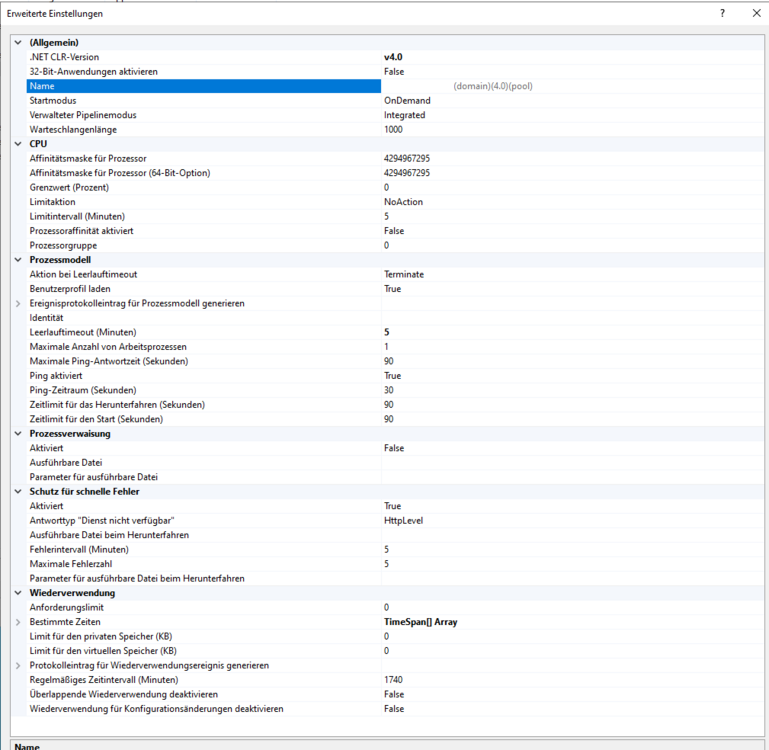
trix0
-
Gesamte Inhalte
13 -
Registriert seit
-
Letzter Besuch
Beiträge erstellt von trix0
-
-
Auf welchem Festplatttentyp (SSD od. HDD) lässt du die VM laufen?
-
Oh tschuldigung, die habe ich ganz vergessen zu erwähnen.
Wenn ich versuche mittels node.js die Anwendung zu "starten" bekomme ich die Fehlermeldung, das ich die Anwendung mittels IISNode benutzen soll.
Wenn ich IISNode verwende (soweit ich bisher erfahren habe, muss man diese in der web.config der jeweiligen Seite einfügen) erhalte ich die Fehlermeldung: 500 Internal Error
-
Servus,
ich will für meine Homepage Node.JS verwenden. diese habe ich dann natürlich installiert, jedoch erhalte ich dann die Fehlermeldung, das ich iisnode anstatt node.js verwenden muss. nach kurzer Recherche bin ich auf diese Anleitung gestoßen: https://github.com/Azure/iisnode
diese ist jedoch für iis 7/8 und funktioniert mit iis 10 nicht. und alle anleitungen etc. die ich dazu finde beziehen sich nur auf iis 7/8. Ist evtl. iisnode bei iis 10 schon integriert und wenn ja, wie kann ich es in meine Seite einbinden?
-
aber was mich wundert. erstellt der IIS nicht automatisch ein cache? zumindest bei Linux server war es so bzw. konnte man es einstellen
-
So ich habe es geschafft

die Webseite braucht jetzt im SCHLIMMSTEN Fall 500ms zum laden.
Das habe ich mit einem Plugin für die Cache-Generierung geschafft.
Bei Google PageSpeed schafft jetzt meine Webseite 96/100 bei der Desktop version und 92/100 bei der Mobilgeräte
-
leider nicht, da ich hierbei ein Programm auf dem Server laufen lassen muss, welche auf Windows-Funktionen zugreift, welche bei Linux nicht vorhanden sind.
was mich eben wundert, ist, das ich bei dem V-Server davor (ebenfalls Windows) gar keine Probleme hatte, obwohl z.B. der Ram und die CPU-Auslastung durch das Programm auf 90% war. Deshalb auch der Wechsel
-
Ja, ja und nein.
Ich hab jetzt nochmal explizietert nachgeschaut. Laut dem Webbrowser braucht er ziemlich lange ("2,33s") um vom Server eine Antwort zu erhalten.

-
da war localhost eingetragen. Das hab ich nun auf 127.0.0.1 abgeändert, Jedoch habe ich hier wieder den selben effekt
Ich habe auch testweise mal alle Erweiterungen in Plesk, welche die Webseite betreffen deaktiviert. Selbes Ergebnis. je öfter ich die Seite aufrufe, umso länger braucht sie zum laden.
Jedoch, wenn ich eine Zeitlang nicht auf die Webseite zugreife, dann lädt sie wieder "Schneller" bzw. braucht dann mit der Änderung der Datenbankserver nur noch 2,33 Sekunden (niedrigster gemessener Wert), aber wenn ich diese dann wieder aktualisiere benötigt es jedesmal eine längere Zeit zum laden der Seite
okay anscheinend braucht er jetzt nicht mehr länger als 4,5 sekunden um die seite zu laden, auch bei aktualisierungen. jedoch finde ich den wert immer noch recht hoch.
-
Die Webseite wird mittels Wordpress und Wocoomerce betrieben. Daher PHP
-
Servus,
meine Webseite lädt immer Langsamer. und bei jedem Neuen Laden, wird dieser immer langsamer:
nach der ersten aktualisierung:
Nach der dritten Aktualisierung:
und am anfang waren es "NUR" 10 Sekunden.
Hier mal meine Einstellungen in IIS:
Er läuft auf einen V-Server mit einem Intel Xeon Processor (Skylake, IBRS) 2.50 GHz (4 Prozessoren) und 16 GB Ram, 500gb NVMe Speicher, mit WIndows 2022. Leider finde ich bei google nur Hilfestellungen für Windows 2016 & 2019, wobei da andere Einstellungen vorhanden waren.
-
So ich hab es jetzt herausgefunden.... Undzwar war unter Tolls & Settings -> Wep Application Firewall -> Web application firewall mode auf ON gestellt. das heißt, das es JEDE eingehende HTTP(S) anfrage abweist. Dise abe ich jetzt Auf "Detection Only" gesetzt. Jetzt funktioniert es

-
Servus,
ich bin von einem V-Server (Window Server 2022) auf einen Root Server (Windows Server 2022) umgestiegen. Auf dem V-Server hat alles wunderbar geklappt. Deshalb bin ich dann auch aufgrund der Ladegeschwindigket und Auslastung auf einen Rootserver umgestiegen.
Ich hatte und habe auf dem Server Plesk installiert und habe dort auch meine Domain eingebunden. Dieser hat der Provider, bei dem ich dem Root Server und auch den V-Server habe, umgeschrieben. Die Webseite ist auch erreichbar, nur erhalte ich ständig den Fehler "403 Forbidden You do not have permission to access this document." (Von Plesk). Ich habe auch schon das Verzeichniss mittels Plesk (Diagnose & Repair) repariert, leider jedoch ohne erfolg. Ich denke, es wird an den Berechtigungen der Ordner bzw. der Dateien sein. Welche Rechte werden benötigt, das Plesk bzw. der Webserver von Windows zugriffsrechte auf die Ordner bekommt?
Ansonsten weiß ich nämlich auch nicht mehr weiter, woran es liegen könnte.
Gruß
trix0






node.js für iis 10
in Windows Server Forum
Geschrieben · bearbeitet von trix0
So, also die Fehlermeldung 500 kommt nur, wenn ich folgendes in die web.config einfüge:
wenn ich diese wieder lösche, funktioniert meine Webseite wieder.
Der Error, der mir in Plesk angezeigt wird:
nur die detailierte Fehlermeldung kann ich nicht aktivieren, bzw. finde hier den Punkt zum aktivieren nicht. bzw ich erhalte diese Fehlermeldung: